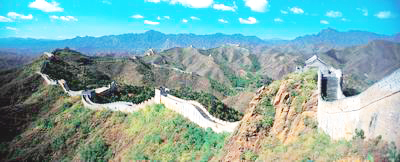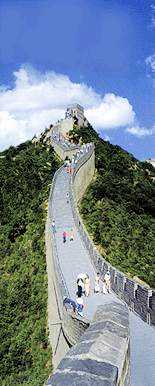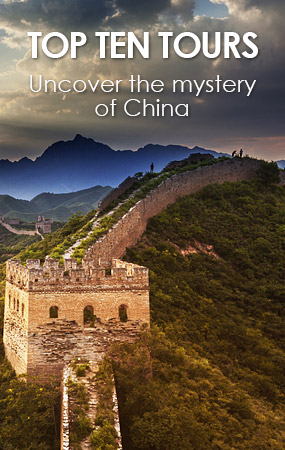Great Wall History
Brief introduction to the Great Wall - the symbol of China
Great Wall Facts
The Great Wall extends for a good 3,000 miles from its origin at the seaside in Shanhaiguan (the Old Dragon Head), a seaport along the coast of Bohai Bay in the east, all the way to Jiayu Pass in Gansu Province. Stretching from the eastern part of Liaoning in Northeast China to Lintao (in modern Minxian) on the desert in the northwest of China, it passes through Liaoning, Hebei, Beijing, Shanxi, Inner Mongolia, Shaanxi, Ningxia, and Gansu. The Chinese li equals 0.5 kilometer, so the Great Wall is 10,000 li long in Chinese measurement and hence it is known in Chinese as the Ten-Thousand-Li Long Wall. Serious readers who measure it on the map will find out that the actual distance is only about 3,000 kilometers since the wall zigzags along the mountain ridges!
Great Wall History
 The Great Wall was a gigantic defensive project used in ancient times as early as in the 7th century B.C. For self-protection, rival kingdoms built walls around their territories, laying foundations for the present Great Wall. When Qin Shihuang (First Emperor of the Qin) unified the whole country in 221 B.C., the existing walls were linked up and new ones added to counter attacks by the remnants of the defeated states. Undertaking of such a huge project over difficult terrain at that time without any machinery was an extraordinary feat. A workforce of nearly a million, representing one fifth of the whole labor force of the country, was used to build it. Hardship and cruel treatment brought death to many of the laborers, and tragic stories were told, from which folk-tales and legends came into being.
The Great Wall was a gigantic defensive project used in ancient times as early as in the 7th century B.C. For self-protection, rival kingdoms built walls around their territories, laying foundations for the present Great Wall. When Qin Shihuang (First Emperor of the Qin) unified the whole country in 221 B.C., the existing walls were linked up and new ones added to counter attacks by the remnants of the defeated states. Undertaking of such a huge project over difficult terrain at that time without any machinery was an extraordinary feat. A workforce of nearly a million, representing one fifth of the whole labor force of the country, was used to build it. Hardship and cruel treatment brought death to many of the laborers, and tragic stories were told, from which folk-tales and legends came into being.
Subsequent dynasties continued to strengthen and extend the wall. In the Han Dynasty (206 B.C.-A.D. 220) about 500 kilometers were added to the west, bringing it to present-day Jiuquan and Dunhuang. The Tang empire (618-907) expanded its territory and pushed its frontier further north, so the Great Wall ceased to be needed as a barrier against invasions. In the Kin Dynasty, a massive system of earthworks was constructed to check the invasion by the Mongols, and remains can still be found in Heilongjiang and Inner Mongolia.
against invasions. In the Kin Dynasty, a massive system of earthworks was constructed to check the invasion by the Mongols, and remains can still be found in Heilongjiang and Inner Mongolia.
However, the Great Wall did not stop the invasion of the Mongols who conquered the whole country and set up the Yuan Dynasty (1271-1368). In 1368, when Zhu Yuanzhang drove the Mongol Yuan rulers from the throne and established the Ming Dynasty (1368-1644), he started the construction of a new Great Wall to the north of Beijing to secure his northern territories from the remnant Mongol forces since he had established his capital in Nanjing.  The wall was built of stone blocks and bricks instead of the rough stones and clay used on the old walls. The size of the Ming wall was much bigger and it stretched from the Yalu River in Liaoning in the east to Jiayuguan in Gansu in the west for a distance of 12,700 li. The part between Yalu River and Shanhaiguan was damaged because of its less solid construction, but the rest has remained until now because it was solidly built. The Manchus had long-time ambitions to conquer the whole of China but they were held back by the Great Wall until a Ming general helped them enter the Shanhaiguan Pass. The Manchu Qing rulers felt it unnecessary to build the wall so very little reconstruction was done.
The wall was built of stone blocks and bricks instead of the rough stones and clay used on the old walls. The size of the Ming wall was much bigger and it stretched from the Yalu River in Liaoning in the east to Jiayuguan in Gansu in the west for a distance of 12,700 li. The part between Yalu River and Shanhaiguan was damaged because of its less solid construction, but the rest has remained until now because it was solidly built. The Manchus had long-time ambitions to conquer the whole of China but they were held back by the Great Wall until a Ming general helped them enter the Shanhaiguan Pass. The Manchu Qing rulers felt it unnecessary to build the wall so very little reconstruction was done.
Today, travelers from the eight directions all flock to the Great Wall to walk on the only man-made structure visible from space. To look out from one of the guard towers out at the barren mountains and the Wall snaking off into the distance is a view not to be forgotten. Standing on the Wall, you can get a good feel for what the Wall was all about.
Great Wall Sections
The section closest to Beijing city proper is Badaling. This section offers awesome views, but it is also the most crowded, as it is the main Wall featured on all tour routes. Mutianyu is another restored section to the east of Badaling. This section requires a more rigorous climb, however, both Mutianyu and Badaling have cable cars to help you reach the top.
A wilder and less crowded option is to go to the section known as Simatai. This section is much farther away, over 100 kilometers northeast of Beijing, so you will have to make a whole day of a trip here. All of these sections have tours which go there, but the most popular is Badaling, as it is closest.

